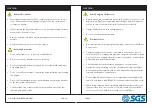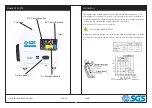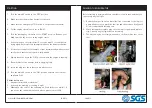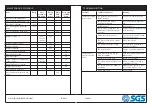
PAGE 5
PAGE 4
WARNING
When Charging The Battery
• Battery electrolyte contains sulphuric acid. Be careful of your eyes, skin
and clothing. Flush thoroughly with water and get prompt medical at-
tention in case of contact, especially if your eyes are affected.
• Charge the battery in a fully ventilated place.
• Be sure to confirm battery polarity.
Electrical Safety
• Electrical equipment (including lines and plug connections) should not
be defective.
• The generating set must not be connected to other power sources
such as the power company supply mains. In special cases where stand-
by connection to existing electrical systems is intended, it shall only be
performed by a qualified electrician.
• Protection against electrical shock depends on circuit breakers
matched to the generating set. If the circuit breakers require replace-
ment they must be replaced with a circuit breaker having identical rat-
ings and performance charateristics.
• Due to high mechanical stresses only tough rubber sheathed flexible
cable (in accordance with IEC245-4) or the equivalent should be used.
• When using extension lines or mobile distribution networks the total
length of lines for a cross section of 1.5mm2 should not exceed 60m;
for cross section of 2.5mm2 this should not exceed 100m.
WARNING
Exhaust Precautions
• Never inhale exhaust gasses. They contain carbon monoxide, a color-
less, odorless and extremely dangerous gas which can cause uncon-
sciousness or death.
• Never operate the generator indoors or in a poorly ventilated outdoor
areas such as a tunnel or cave.
• Exercise extreme care when operating the generator near people or
animals.
• Keep the exhaust pipe free of foreign objects.
Refueling Precautions
• Do not refuel indoors or in a poorly ventilated area.
• Be sure to stop the generator prior to refueling.
• Fuel is combustible and easily ignited. Do not refuel while smoking or
near naked flames.
• Do not over fill the fuel tank. If spilt, wipe away carefully before starting
the engine.
• Diesel fuel oil substitutes are not recommended; they may be harmful
to the fuel system components.
• Fuel should be free of water or dust to prevent damage to the fuel
injection pump and nozzle.
WWW.SGS-ENGINEERING.COM




























